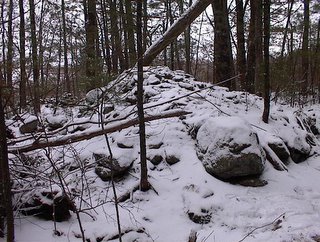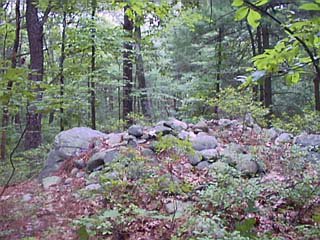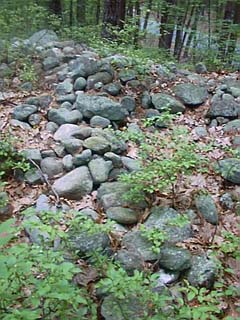 According to one of the links from Bruce M. posted earlier, turtle effigies (possibly like these under discussion) have the head pointing towards water. I cannot say that is true in all cases but it is definately true for that fine pile we saw earlier, from Stow, shown again above. In fact water comes out from a spring underneath the head of this pile.
According to one of the links from Bruce M. posted earlier, turtle effigies (possibly like these under discussion) have the head pointing towards water. I cannot say that is true in all cases but it is definately true for that fine pile we saw earlier, from Stow, shown again above. In fact water comes out from a spring underneath the head of this pile.John Hansen Mitchell in his book "Tresspassing" about the Sarah Doublet Forest in Littleton writes about a serpent mound ending at a turtle pile. Here it is:
 I think this pile has already been vandalised: note the hollow visible in this view from the back.
I think this pile has already been vandalised: note the hollow visible in this view from the back. But look carefully at this picture. I want to point out the small white cobble visible at the very bottom of the picture. It is a cobble made of white feldspar. In my own observations about turtle piles, there seems to be a common event of quartz, or in this case white feldspar, occuring somewhere on the turtle's back. I don't know if this is a true observation but have wondered what it could mean, if it is true. What happens on a turtle's back in Indian stories? Turtle is prominent in the creation story. It holds all the creatures of the world on its back and beaver dives off, brings up some solid dirt, creates land, and relieves turtle of its burden. Following that line of reasoning quartz becomes a metaphor for all the spirits of the living. Which makes a kind of sense.
But look carefully at this picture. I want to point out the small white cobble visible at the very bottom of the picture. It is a cobble made of white feldspar. In my own observations about turtle piles, there seems to be a common event of quartz, or in this case white feldspar, occuring somewhere on the turtle's back. I don't know if this is a true observation but have wondered what it could mean, if it is true. What happens on a turtle's back in Indian stories? Turtle is prominent in the creation story. It holds all the creatures of the world on its back and beaver dives off, brings up some solid dirt, creates land, and relieves turtle of its burden. Following that line of reasoning quartz becomes a metaphor for all the spirits of the living. Which makes a kind of sense.Lest it be forgotten because of its obscurity here is one more pile that kind of qualifies.:
 It is somewhere on the Weatherbee Conservation Land in Acton. I found it, lost it, found it again. You can go have a try. One time I was at it and experienced a curious vibration underfoot. Dunno about that. Where is the quartz? it is off in front of the turtle, not visible in the picture.
It is somewhere on the Weatherbee Conservation Land in Acton. I found it, lost it, found it again. You can go have a try. One time I was at it and experienced a curious vibration underfoot. Dunno about that. Where is the quartz? it is off in front of the turtle, not visible in the picture.If you are interested there are some other turtles in the NEARA photos.
1 comment :
There is more than one example of a serpent pile whose head is near a turtle pile.
Post a Comment